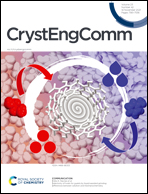Two Co(ii)-based coordination polymers as multi-responsive luminescent sensors for the detection of levofloxacin, benzaldehyde and Fe3+ ions in water media†
Abstract
Two new ternary metal coordination polymers (CPs), [Co(OBA)(L1)0.5]n (1) and [Co(HBTC)(L2)]n (2) (H2OBA = 4,4′-oxybis(benzoic acid), H3BTC = 1,3,5-benzenetricarboxylic acid, L1 = 1,3-bis(1-(pyridin-4-ylmethyl)-1H-benzimidazol-2-yl)propane, and L2 = 1,4-bis(benzimidazol-1-yl)-2-butene), were synthesized under hydrothermal conditions and characterized. 1 features a unique 2D (3,3,4)-connected layer which further extended into a 3D framework through intra-molecular π–π stacking interactions. 2 exhibits a 3D 3,5T21 network with the point symbol of (42·65·83)(42·6). The two CPs present high thermal and chemical stabilities in the pH range from 3 to 12. Moreover, 1/2 can detect levofloxacin (LEV), benzaldehyde (BZH) and Fe3+ ions in aqueous solution through the fluorescence quenching process with excellent sensitivity, selectivity, recyclability and extremely low detection limits.

- This article is part of the themed collection: Coordination Networks


 Please wait while we load your content...
Please wait while we load your content...